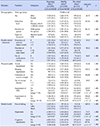2. Tinetti ME, Speechley M, Ginter SF. Risk factors for falls among elderly persons living in the community. The New England Journal of Medicine. 1988; 319(26):1701–1707. DOI:
10.1056/nejm198812293192604.

3. Morris JN, Howard EP, Steel K, Berg K, Tchalla A, Munankarmi A, et al. Strategies to reduce the risk of falling: Cohort study analysis with 1-year follow-up in community dwelling older adults. BioMed Central Geriatrics. 2016; 16:92. DOI:
10.1186/s12877-016-0267-5.

4. Jang IS, Park EO. The prevalence and factors of falls among the community-dwelling elderly. Journal of Korean Public Health Nursing. 2013; 27(1):89–101. DOI:
10.5932/JKPHN.2013.27.1.89.

5. Kim YH, Yang KH, Park KS. Fall experience and risk factors for falls among the community-dwelling elderly. Journal of Muscle and Joint Health. 2013; 20(2):91–101. DOI:
10.5953/JMJH.2013.20.2.91.

6. Lukaszyk C, Harvey L, Sherrington C, Keay L, Tiedemann A, Coombes J, et al. Risk factors, incidence, consequences and prevention strategies for falls and fall-injury within older indigenous populations: A systematic review. Australian and New Zealand Journal of Public Health. 2016; 40(6):564–568. DOI:
10.1111/1753-6405.12585.

7. Park Y, Paik NJ, Kim KW, Jang HC, Lim JY. Depressive symptoms, falls, and fear of falling in old Korean adults: The Korean Longitudinal Study on Health and Aging (KLoSHA). The Journal of Frailty & Aging. 2017; 6(3):144–147. DOI:
10.14283/jfa.2017.21.
8. Jeon M, Gu MO, Yim J. Comparison of walking, muscle strength, balance, and fear of falling between repeated fall group, one-time fall group, and nonfall group of the elderly receiving home care service. Asian Nursing Research. 2017; 11(4):290–296. DOI:
10.1016/j.anr.2017.11.003.

9. Noh JW, Kim KB, Lee JH, Lee BH, Kwon YD, Lee SH. The elderly and falls: Factors associated with quality of life A cross-sectional study using large-scale national data in Korea. Archives of Gerontology and Geriatrics. 2017; 73:279–283. DOI:
10.1016/j.archger.2017.08.008.

10. Yoo IY, Choi JH. Experience of falls and predictors of falls in the elderly at senior citizens' centers. Journal of Korean Academy of Community Health Nursing. 2007; 18(1):14–22.
11. Nam IS, Yoon HS. An analysis of the interrelationship between depression and falls in Korean older people. Journal of the Korean Gerontological Society. 2014; 34(3):523–537.
12. Yun ES. Fall prediction model for community-dwelling elders based on gender. Journal of Korean Academy of Nursing. 2012; 42(6):810–818. DOI:
10.4040/jkan.2012.42.6.810.

13. Rubenstein LZ. Falls in older people: Epidemiology, risk factors and strategies for prevention. Age and Ageing. 2006; 35:Suppl 2. ii37–ii41. DOI:
10.1093/ageing/afl084.

14. Kvelde T, McVeigh C, Toson B, Greenaway M, Lord SR, Delbaere K, et al. Depressive symptomatology as a risk factor for falls in older people: Systematic review and meta-analysis. Journal of the American Geriatrics Society. 2013; 61(5):694–706. DOI:
10.1111/jgs.12209.

15. Graveson J, Bauermeister S, McKeown D, Bunce D. Intraindividual reaction time variability, falls, and gait in old age: A systematic review. Journals of Gerontology. Series B, Psychological Sciences and Social Sciences. 2016; 71(5):857–864. DOI:
10.1093/geronb/gbv027.

16. Panel on Prevention of Falls in Older Persons. American Geriatrics Society and British Geriatrics Society. Summary of the Updated American Geriatrics Society/British Geriatrics Society clinical practice guideline for prevention of falls in older persons. Journal of the American Geriatrics Society. 2011; 59(1):148–157. DOI:
10.1111/j.1532-5415.2010.03234.x.
17. Taylor-Piliae RE, Peterson R, Mohler MJ. Clinical and community strategies to prevent falls and fall-related injuries among community-dwelling older adults. Nursing Clinics of North America. 2017; 52(3):489–497. DOI:
10.1016/j.cnur.2017.04.004.

21. Won CW, Rho YG, Kim SY, Cho BR, Lee YS. The validity and reliability of Korean Activities of Daily Living (K-ADL) scale. Journal of the Korean Geriatrics Society. 2002; 6(2):98–106.
22. Yesavage JA, Sheikh JI. 9/Geriatric Depression Scale (GDS): Recent evidence and development of a shorter version. Clinical Gerontologist. 1986; 5(1-2):165–173. DOI:
10.1300/J018v05n01_09.
23. Han JW, Kim TH, Jhoo JH, Park JH, Kim JL, Ryu SH, et al. A normative study of the Mini-Mental State Examination for Dementia Screening (MMSE-DS) and its short form (SMMSE-DS) in the Korean elderly. Journal of Korean Geriatric Psychiatry. 2010; 14(1):27–37.
https://doi.org/G704-SER000001759.2010.14.1.008.

24. Denkinger MD, Lukas A, Nikolaus T, Hauer K. Factors associated with fear of falling and associated activity restriction in community-dwelling older adults: A systematic review. American Journal of Geriatric Psychiatry. 2015; 23(1):72–86. DOI:
10.1016/j.jagp.2014.03.002.
25. Hajek A, Bock JO, Konig HH. Psychological correlates of fear of falling: Findings from the German Aging Survey. Geriatrics & Gerontology International. 2018; 18(3):396–406. DOI:
10.1111/ggi.13190.

26. Tak YR, An JY. Risk factors for recurrent falls among home-dwelling elderly in Korea. Journal of the Korean Society of Living Environmental System. 2011; 18(3):291–300.
27. Greenberg SA, Sullivan-Marx E, Sommers ML, Chittams J, Cacchione PZ. Measuring fear of falling among high-risk, urban, community-dwelling older adults. Geriatric Nursing. 2016; 37(6):489–495. DOI:
10.1016/j.gerinurse.2016.08.018.

28. Jiam NT, Li C, Agrawal Y. Hearing loss and falls: A systematic review and meta-analysis. Laryngoscope. 2016; 126(11):2587–2596. DOI:
10.1002/lary.25927.







 PDF
PDF ePub
ePub Citation
Citation Print
Print




 XML Download
XML Download